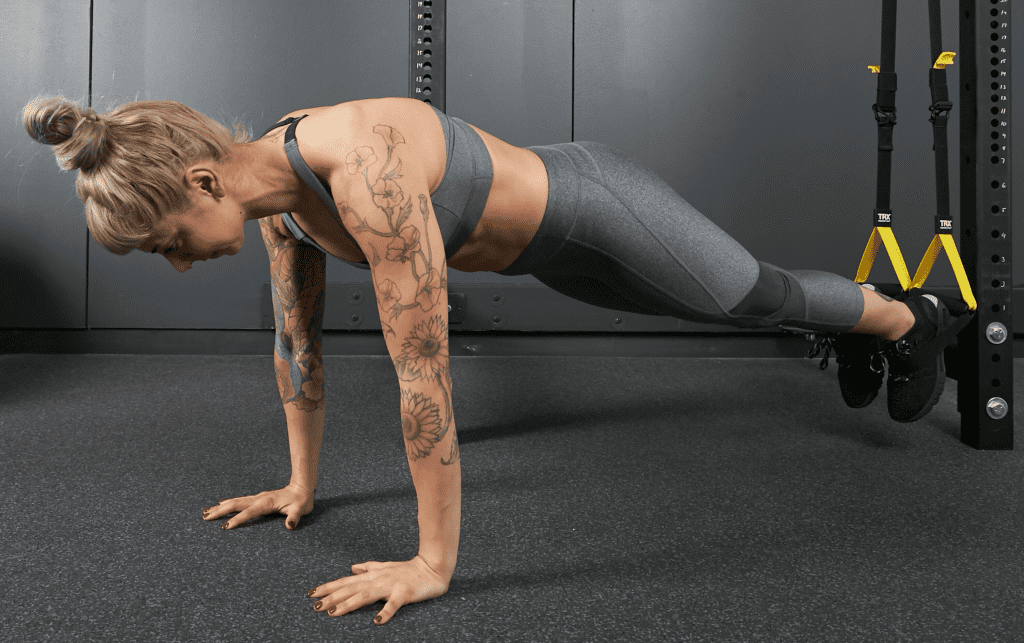The TRX Suspension TrainerT is one of the most versatile pieces of equipment in the gym or your home gym. You can take it pretty much anywhere — and it unlocks countless bodyweight exercises to help you achieve amazing results.
We asked Shana Verstegen, a personal trainer and TRX Master Instructor, for the top exercises she recommends to get started using the long, yellow and black straps. With these moves, you’ll jump-start your fitness journey as you build muscle and lose fat.
1. TRX PLANK
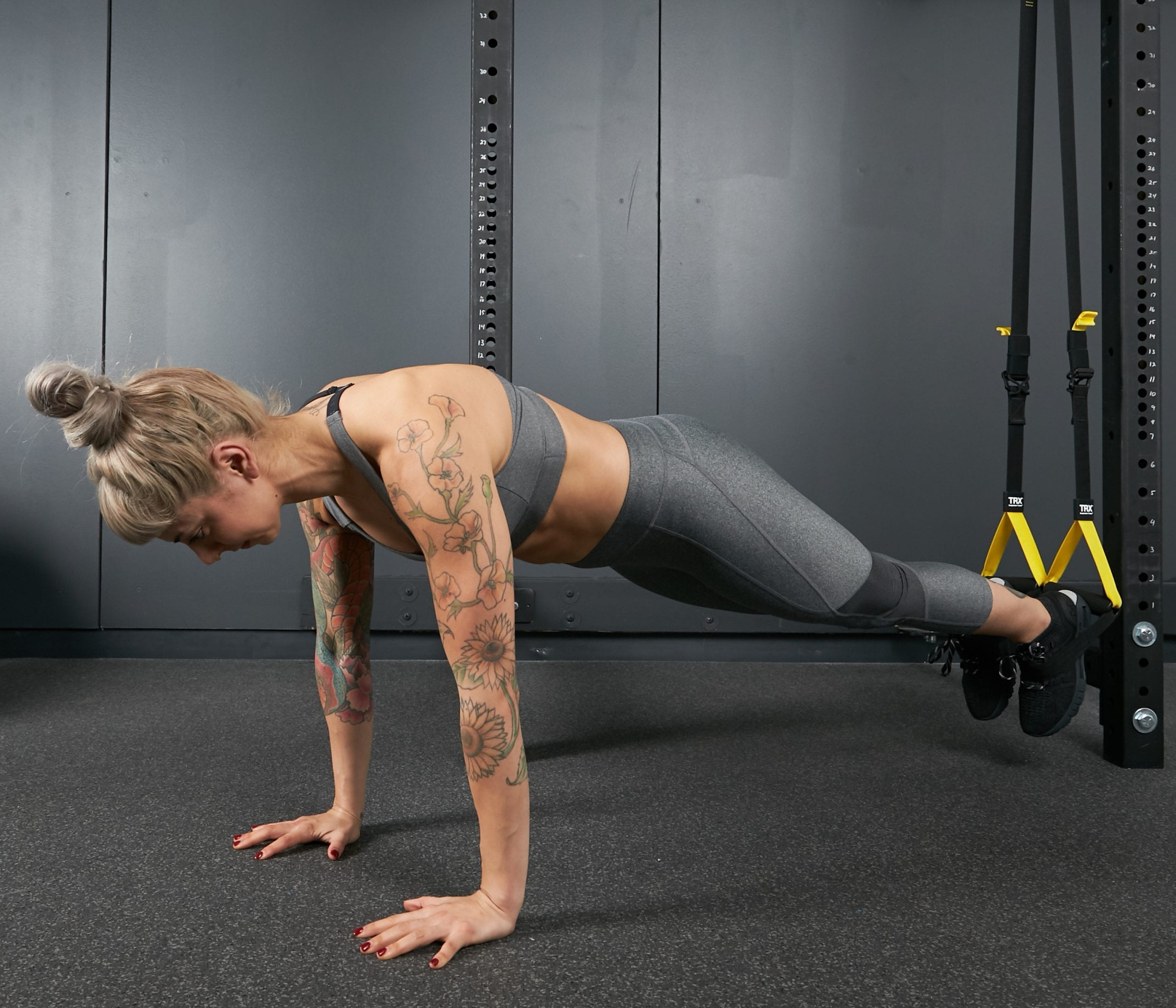
Why you should do it: “Establishing a strong core is essential for all beginners,” says Verstegen. “The ability to keep the body aligned and contracted will lead to safe and successful performances in all other exercises.”
The move: With the straps at midcalf, begin by lying on your stomach facing away from the anchor point and place your toes into the foot cradles. Drive the heels back into the handles, squeeze the calves, quads, glutes, hamstrings and core, and press into a perfectly flat plank.
Hold for as long as you can or up to 30 seconds. Repeat for three total sets.
Pro tip: If you’re having trouble getting your toes in the straps, follow these three steps:
- Sit facing the anchor point with the bottom of the foot cradles hanging 8–12 inches above the ground. Your knees should be about a foot from the straps.
- Shift your weight to your right hip. With your right foot in the left foot cradle, cross your left foot over your right and place it into the right foot cradle. Point your toes.
- Roll your body over to the right into a plank position, allowing your feet to rotate inside the foot cradles. Your upper body should be supported by your forearms or your hands in a pushup position. Rest by placing your knees on the ground and assuming a position on your hands and knees.
2. TRX INVERTED ROW
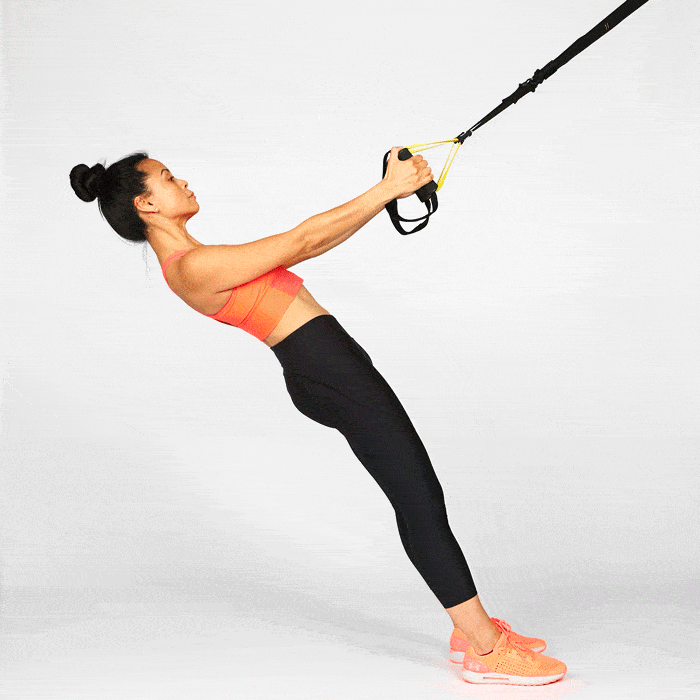
Why you should do it: “The row is essential for proper posture,” says Verstegen. Not only is the TRX row great at targeting your back muscles, you can easily change the intensity by moving your feet closer or further from the anchor point, she adds.
The move: With the suspension trainer shortened, stand facing the anchor point. Begin with your elbows bent at 90 degrees, the handles at your rib cage, body straight and planked. Slowly straighten your arms to lower your body, keeping your body in a straight line from head to toe and return to the start by bending the elbows.
Perform three sets of 8–10 reps.
3. TRX SINGLE ARM ROW
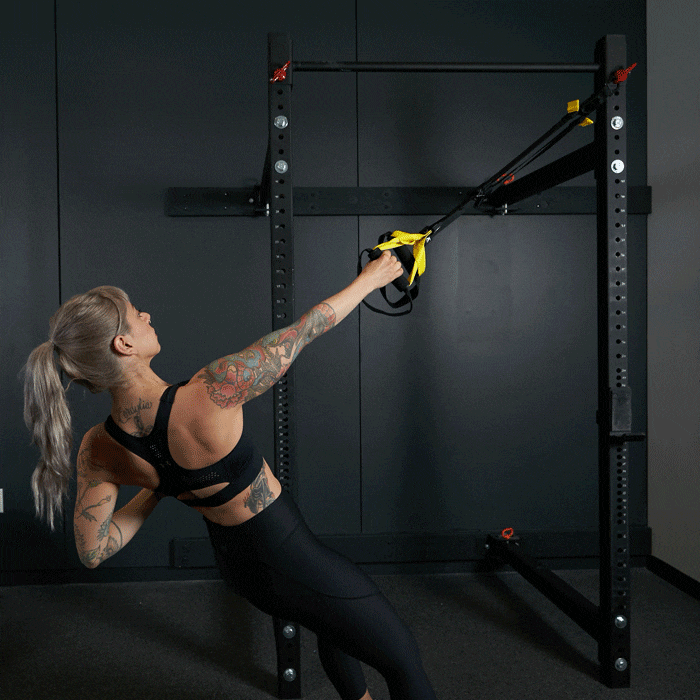
Why you should do it: Chances are, most of your exercises target both arms or both legs at the same time like a squat, dead lift or pushup. Yet by using exercises that target each arm and leg separately — called “unilateral training” — you can unlock tremendous improvements for your fitness and body.
The move: Take one TRX strap from underneath with your feet closer to the anchor point. Squeeze your shoulder blades together and pull yourself up while keeping your body straight like a plank. Don’t let your body twist.
Perform three sets of 8–10 reps.
4. TRX SQUAT
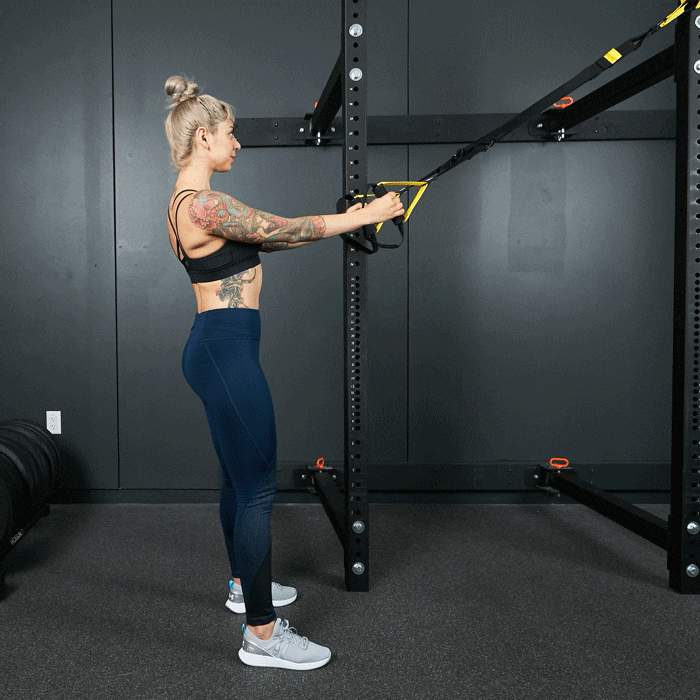
Why you should do it: Regardless of your fitness level, squats offer incredible benefits. “The TRX squat will improve hip mobility and squatting mechanics, which can be carried over into the squat rack, movements of daily living and virtually any sport,” Verstegen explains.
The move: Adjust the TRX straps to mid-length, and stand facing the anchor point. Hold the handles in front of you with your elbows soft, and step backward until there is slight tension on the straps. Without leaning backward, lower your hips down and back as low as you are comfortable going. Squeeze your glutes as you return to a standing position.
Perform three sets of 8–10 reps.
5. TRX CHEST PRESS
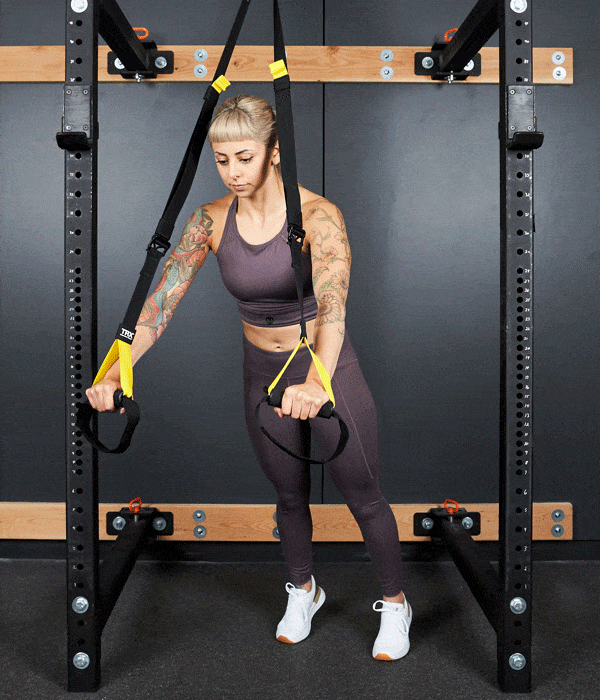
Why you should do it: “The chest press is a great tool to not only teach pushing with proper alignment, but also to engage the core for a strong, stable spine,” says Verstegen. No wonder it’s a staple for TRX coaches.
The move: Fully lengthen the TRX straps and stand facing away from the anchor point. Begin on the balls of your feet and with your arms extended directly below your shoulders, pushing against the handles of the straps. Keeping your body in a straight plank, lower yourself until your elbows are at about 90 degrees. Straighten your arms and brace your core as you press back up to the starting position.
Perform three sets of 8–10 reps.
6. TRX ALTERNATING LUNGES
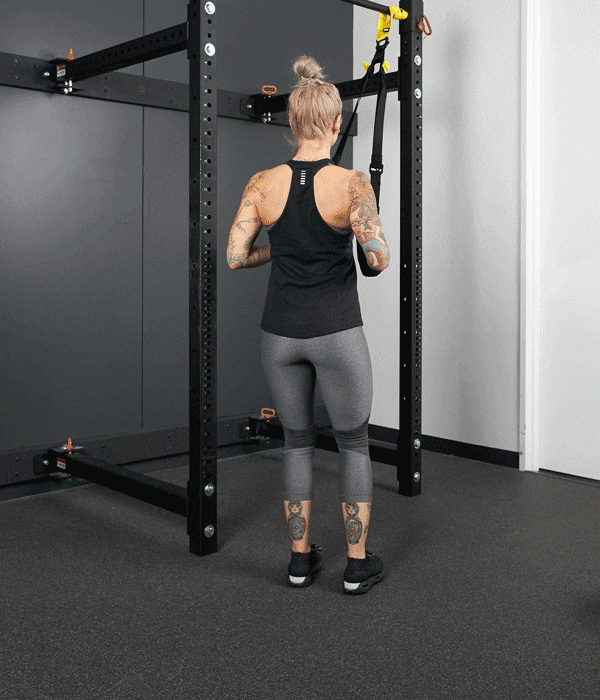
Why you should do it: “Many beginners spend most of their time moving front-to-back, yet neglect lateral (side-to-side) movement,” Verstegen explains. By holding onto the TRX straps, you can improve your technique and mobility with the lateral lunge, especially if you’re new to the movement.
The move: Begin with the straps at mid-length. Stand facing the anchor point with your legs in a wide stance and toes pointed forward. Drop your left hip down and back over your left heel as low as you are comfortable going. Press through your leg to stand back up to starting position. Repeat on the other side. That’s one rep.
Perform three sets of 8–10 reps.
7. TRX BICEPS CURL
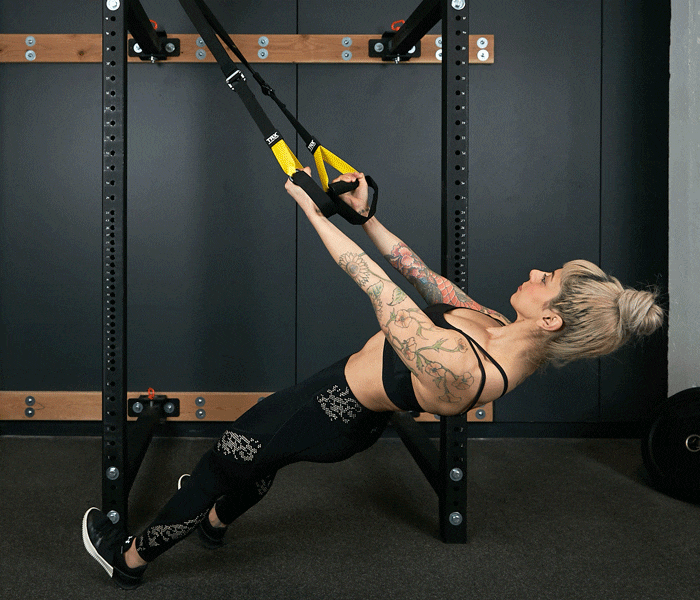
Why you should do it: Grab a TRX and lean back with your arms straight. This is the same starting position as a TRX row.
The move: With your palms facing up, curl your hands in toward your shoulders. As you curl, don’t let your arms lower toward your sides. The only thing moving should be your forearm and elbow. Everything else remains in place.
Perform three sets of 8–10 reps.
8. TRX HAMSTRING CURLS
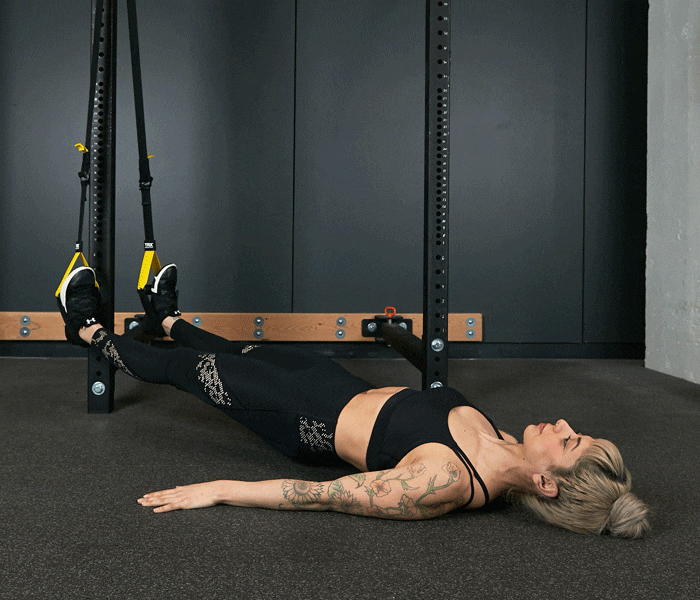
Why you should do it: “Hamstring strength is essential for knee joint integrity and the ability to run, jump, kick and more,” Verstegen explains. Beginners and pros alike benefit from this exercise.
The move: With the straps at midcalf length, lie on your back facing the anchor point and place your heels in the foot cradles. Keep even pressure in your heels, engage your glutes and core, keep your hips lifted and drag your heels as if they were on train tracks until your knees are stacked over your hips. Return your legs to straight while maintaining a tight core.
Perform three sets of 8–10 reps.
Pro tip: If you’re having trouble getting your feet in the cradles, follow these three steps:
- Sit facing the TRX Suspension Trainer with the bottom of the foot cradles hanging 8–12 inches above the ground. Your knees should be about a foot from the straps. Hold each foot cradle in place with your index and middle fingers.
- Roll onto your back, bringing both knees into your chest and place both heels into the foot cradles simultaneously. Ensure your heels are fully supported by the foot cradles.
- Straighten your legs and you’re ready to go. As an alternative technique, you can also perform these exercises with your toes through the foot cradles and weight resting on the arches of your feet. Experiment to see which way you prefer.
9. TRX Y-FLY
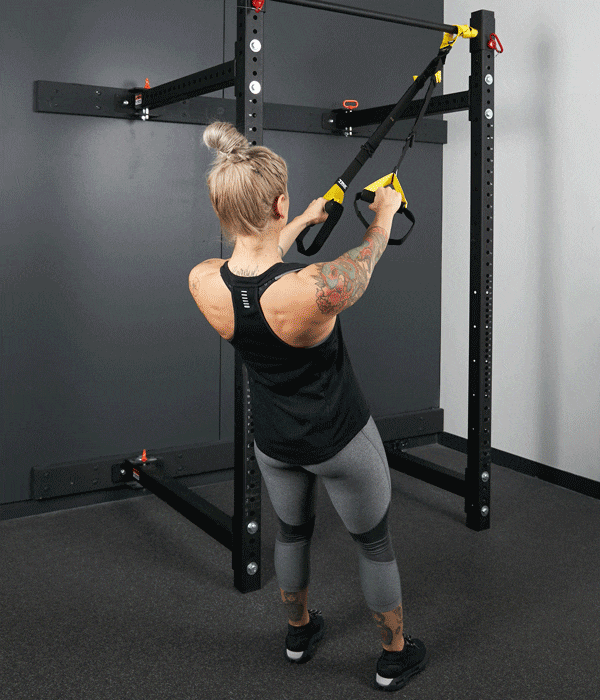
Why you should do it: The TRX also has many uses for injury prevention and improving posture. “The Y-Fly focuses on the mobility of the shoulders and the strength of the upper back,” says Verstegen. “Perfecting this exercise will help you achieve great posture.”
The move: Adjust the TRX straps to mid-length, and stand facing the anchor point. Begin with your arms in a “Y” position above your head and select either a hip-width stance or have your feet slightly offset. Slowly lower your body backward, keeping a straight plank. Keep your arms straight as you return to the standing “Y” position.
Perform three sets of 8–10 reps.




